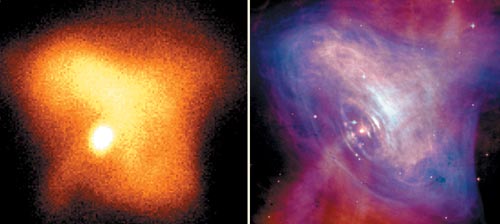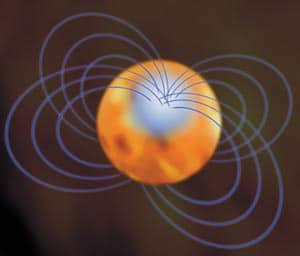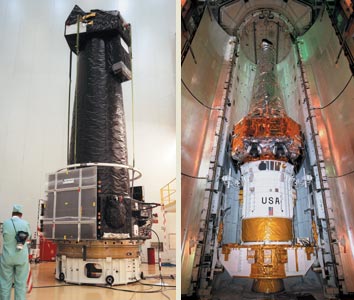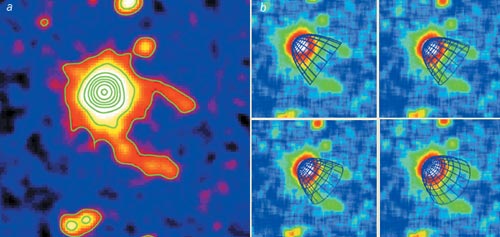Neutron stars might be the dimmest objects in the universe but they are also cosmic laboratories for extreme physics that are tailor-made for X-ray and gamma-ray astronomy

Legend has it that when word reached Copenhagen of the discovery of the neutron in 1932, Niels Bohr threw a great party at his home. Among his guests was a young Russian named Lev Landau, who is said to have quietly remarked that “stars could be made with this new particle”. Astronomers like to think that this was said in earnest – and not under the influence of Danish hospitality – because we now know that neutron stars really do exist.
The characteristics of neutron stars were first described two years later by Walter Baade and Fritz Zwicky at the California Institute of Technology, but astronomers had to wait until 1968 to actually detect one. That was when Jocelyn Bell, then a PhD student, and her supervisor Anthony Hewish (the only person to get a share of the 1974 Nobel prize for the discovery) came across a series of faint, pulsed radio signals while studying quasars at Cambridge University. The period of these signals was so precise that they were initially thought to be signs of extraterrestrial intelligence.
After further sources were detected, Franco Pacini – who later became president of the International Astronomical Union – and Tommy Gold interpreted the signals as a “lighthouse” effect. Although Pacini and Gold were both at Cornell University at the time, they concluded independently that the radio beams were being emitted by a rotating, highly magnetized neutron star.
This explanation – in which the radio waves are produced by synchrotron radiation from relativistic particles that are accelerated by the star’s magnetic field – was quickly verified, but not soon enough to prevent rotating, magnetized neutron stars from being called “pulsars”. This term – a contraction of “pulsating star” – was coined by a journalist from the Daily Telegraph who was present during the first discussions about the mysterious radio pulses. Had he waited a week or so for the correct interpretation to emerge, what would we be calling pulsars now – rotars? neutrars?
Compact stars
Neutron stars are compact objects that pack a mass comparable to that of the Sun into a volume about 20 km across (figure 1). They are thought to originate in supernova explosions as the result of a gravitational collapse, and can be said to be one stop short of a black hole in the evolution of a massive star. The structure of a neutron star is determined by an equation of state – which relates its pressure to its density – and constraining this equation of state is a major goal in neutron-star astronomy.
The density of a neutron star is close to that of a nucleus, but depending on its precise equation of state, the composition of a neutron star can vary from neutrons and protons to hyperons – particles that contain strange quarks – and possibly even free quarks. A neutron star that weighs more than 1.6 solar masses, for example, would require an equation of state that incorporated “exotic” matter. However, most neutron stars have a mass of about 1.35 solar masses, albeit with interesting exceptions. So far no evidence has arisen for “strange” stars – neutron stars that contain strange quarks – but the search is on, and the equation of state is our best tool in the hunt.
The magnetic field of a neutron star, which is boosted to about 108 T by its gravitational collapse, is also an important factor in determining its equation of state. Furthermore, the conservation of angular momentum implies that neutron stars and their magnetic fields rotate rapidly, with periods varying from milliseconds to seconds. This means that neutron stars are formidable radiation emitters and particle accelerators.
In 1970 Riccardo Giacconi and colleagues at American Science and Engineering stumbled across a new class of celestial X-ray sources that were bright and variable with a fast periodicity. Giacconi, who shared the 2002 Nobel Prize for Physics, was on his way to showing that neutron stars could be bound in binary systems along with normal stars. However, the extreme density of neutron stars makes their orbits much tighter, and their periods much shorter, than those of normal star-meets-star binaries.
Moreover, the gravitational attraction of a neutron star is so strong that it actually pulls some of the external layers of the normal star onto itself. This accretion process follows the laws of celestial mechanics and gravitation, and the in-falling matter can organize itself into a disk that rotates around the neutron star. The temperature of this disk can be as high as 106 K due to internal viscosity and friction, which makes it visible in the X-ray region. The disk can also be eclipsed and give rise to spectacular variations in the star’s X-ray flux, which provides an excellent hook for understanding a binary system. To paraphrase what John Wheeler is supposed to have said after the discovery of neutron stars, “who suspected that they would come equipped with a bell and a handle?”.
An enormous amount of data at various wavelengths has been collected from binary systems in the three decades since their discovery, and they remain one of the most important sources of neutron-star phenomenology. In particular, astronomers can calculate the mass of a neutron star by studying the gravitational interaction of the binary system.
In 1974 Russell Hulse and Joe Taylor, then at the University of Massachusetts, discovered the first binary system that contained two neutron stars. The dynamical behaviour of this extreme system provided the first indirect evidence for gravitational waves, for which Hulse and Taylor shared the 1993 Nobel Prize for Physics.
Today some 10 neutron-star-neutron-star binaries have been discovered, and radio astronomy has accumulated a spectacular database of more than 1500 pulsars. Indeed, radio astronomy can also be used to study the equation of state of neutron stars. Since 1969 astronomers have found 25 pulsars that show “glitches” in their rotation periods, which are normally extremely precise. These glitches are thought to be caused by the transfer of angular momentum from the fast-rotating, superfluid core of a neutron star to its solid crust.
Andrew Lyne’s group at the University of Manchester has recently observed intermittent behaviour in the radio pulsar PSRB1828-11. This could be the first example of a freely precessing, or “wobbling”, neutron star – something ruled out by many equations of state (see Physics World October 2000 pp27-28). Meanwhile, Curt Cutler at the Max Planck Institute for Gravitational Physics in Germany and co-workers at Caltech and Montana State University have analysed the impact of the behaviour of PSRB1828-11 on the rigidity of its crust. They concluded that the crust of the star is under significant stress, which has far-reaching implications. Stay tuned for more broadcasts from this new radio station.
High-energy window
Neutron stars do not have any nuclear fuel so they do not shine like other stars. But this does not mean that we cannot see them. Indeed, neutron stars are tailor-made for multi-wavelength astronomy, and their extremely high temperatures make them especially interesting sources of high-energy astrophysics. Just as no one doubts that the ancient Chinese invented gunpowder for shooting pheasants, I firmly believe that X-ray and gamma-ray astronomy were invented for studying neutron stars.
After Giacconi and colleagues made the first satellite measurements of binary systems, a crescendo of observational missions took place. Particularly important were the Einstein Observatory, the German ROSAT mission and a number of impressive Japanese missions. More recently two higher-energy gamma-ray observatories were launched – Italy’s BeppoSAX and NASA’s Rossi XTE. These missions were named in honour of two lifelong friends, Beppo Occhialini and Bruno Rossi.
The hot news in neutron-star astronomy, very much in the literal sense, has come from the two great X-ray observatories XMM-Newton and Chandra (figure 2). Until recently, many astronomers thought that neutron stars contained a complex atmosphere that would modify their black-body-like surface radiation. However, this view has now changed thanks to striking X-ray measurements of the surface of isolated neutron stars, which can reach temperatures of a few million degrees.
Isolated neutron stars, as opposed to those in binary pairs, appear to have featureless, black-body spectra that do not contain any telltale atmospheric features – at least not for the dozen cases for which we have good enough data. The only notable exception is 1E1207.4-5209. Recent data from XMM-Newton show that the absorption spectrum of this neutron star contains a series of intriguing features, which occur at energies that are integer multiples of 0.7 keV (see Physics World July 2003 p3). To neutron-star astronomers this is immediately recognizable as being due to cyclotron resonance absorption – a process whereby electrons or protons at the surface of the neutron star oscillate due to the star’s magnetic field, which causes them to absorb photons at a particular energy.
The immediate consequence of this is that the magnetic field of an isolated neutron star can be directly measured for the first time, and not just evaluated according to models of a rotating dipole. Furthermore, if the particles responsible are electrons – as most astronomers believe – the measured magnetic field for 1E1207.4-5209 works out to be just 8 x 106 T. Although huge by terrestrial standards, this is much lower than expected, and the discrepancy is still not understood. It might involve fine-tuning the theory that describes the generation and decay of magnetic fields in isolated neutron stars. However, it could also be due to a trapped-particle belt around the star – much like the Van Allen belts surrounding the Earth – or even a disk of debris orbiting the star.
Atmospheric results
Any debris that surrounds a neutron star is good news for astronomers. Indeed, the first extrasolar planets to be discovered were in orbit around the pulsar PSR1257+12 (see Physics World July 1997 pp31-36). An atmosphere that forms by the accretion of gaseous material can enhance and even distort the high-temperature phenomena that take place near a neutron star. It is therefore our best diagnostic tool for understanding neutron-star physics.
A case in point is a recent measurement of the atmosphere of EXO0748-676 – a neutron star with a low-mass companion star – which emits frequent bursts of intense X-rays. Jean Cottam at NASA’s Goddard Space Flight Center, Fritz Paerels at Columbia University in New York and Mariano Mendez at the SRON Institute for Space Research in the Netherlands measured the gravitational redshift of the X-ray lines that are emitted close to the surface of this neutron star for the first time. From this they were able to estimate the ratio of the star’s mass to its radius, and thus constrain its equation of state (see Cottam et al. in further reading).
The fact that this low-mass X-ray binary system undergoes significant “bursting” activity is probably due to its intermittent accretion. More than 20 bursts were observed by XMM-Newton in early 2000, and the quality of the spectra was so good that several atomic absorption lines of iron and oxygen could be seen. To identify them, however, Cottam and co-workers had to systematically shift the lines to longer wavelengths by a redshift z = 0.35. This is precisely the value that would be expected for a photon trying to overcome the gravitational field of a “standard” neutron star. The researchers were able to constrain the mass of the neutron star to be between 1.4 and 1.8 solar masses and its radius to be 9-12 km, thereby ruling out equations of state based on exotic states of matter, such as strange quarks.
Meanwhile, Craig Heinke and co-workers at the Harvard-Smithsonian Center for Astrophysics have used the Chandra X-ray satellite to study neutron stars in two binary system in the globular cluster 47 Tucanae. These objects undergo periodic accretion and as a result they probably have a hydrogen atmosphere that may even contain metals. More interestingly, however, one of these neutron stars appears to have a mass that is about 1.8 times larger than the mass of the Sun and a radius that is between 9 and 16 km.
If confirmed, this observation would place a severe constraint on the neutron-star equation of state. In particular, it would rule out a “soft” equation of state for the core of the star, which includes Bose-Einstein condensates of kaons, hyperons and pions. The result is also compatible with the mass range found by Cottam and co-workers using the gravitational-redshift data, which supports a non-exotic picture of the composition of neutron stars.
Mystery star
The latest demonstration of the power of modern X-ray observatories has come from measurements of the neutron star Geminga, which is located in the Gemini constellation. Geminga was discovered in 1973 by the NASA gamma-ray observatory SAS-2, but it remained a mystery for the next 20 years. Indeed, its name derives from a pun in Milanese dialect in which “Gh’é minga” means “it does not exist”. The X-ray emission of Geminga later revealed an isolated neutron star that pulsated with period of 237 ms, and ground-based observations in the optical region showed that this star was travelling relatively fast – a strong indication of its local nature. The Hubble Space Telescope revealed that Geminga is 522 light-years away, and also provided an absolute measure of its luminosity.
A few months ago the European Photon Imaging Camera on board XMM-Newton recorded a stunning image of Geminga (figure 3). This showed that the neutron star is trailed by a diffuse X-ray emission in the shape of two “tails” that are accurately aligned with the object’s motion in the sky. This tale of two tails is best told by considering that Geminga travels through the interstellar medium at about 20 times the local speed of sound. The star is therefore surrounded by a strong “bow shock”, which compresses its magnetic field and traps high energy electrons that it emits as it rotates. Astonishingly, the combination of these ultrahigh-energy 1014 eV electrons and the 10-5 G field is just right for producing the keV photons that XMM-Newton is sensitive to (see Caraveo et al. in further reading).
The mechanism behind the emission of these photons is magneto-synchrotron radiation, whereby an electron emits photons when it gyrates in a magnetic field. In fact, the radius of this Larmour gyration turns out to be precisely the same as the thickness of Geminga’s tails – about 6 x 1014 m. And the time it takes for electrons to lose most of their energy via synchrotron radiation in the compressed magnetic field is calculated to be about 1000 years, which is precisely the time it takes for the star to travel a distance equal to the length of its tails.
A dim future
The X-ray tails of Geminga were therefore probably ignited around the time of the Battle of Hastings. It would be pushing things, however, to claim that the Bayeux tapestry mistook Geminga for Halley’s comet! Astronomers should be content with having notched up yet another first with Geminga. Its tails allows us to probe the physics of the interaction between an isolated neutron star and the interstellar medium. They also provide solid evidence for the acceleration of ultrahigh-energy particles in a local magnetic field, which, in turn, provides a direct measurement of the field.
Where the next Nobel prize in neutron-star astronomy will come from we do not know, but the immediate future of the field looks particularly promising. Chandra and XMM-Newton are almost certain to find more telltale spectral features and perhaps bow shocks in other neutron stars. Great expectations are also being raised by the International Gamma-Ray Astronomy Laboratory (INTEGRAL), which was launched by ESA in October 2002. Meanwhile, the world’s largest astronomical facility – ESO’s Very Large Telescope – is preparing a second generation of instruments that are geared to fainter and fainter objects.
Neutron stars, alas, fall into that category. Geminga might be one of the best understood isolated neutron stars that we have found, but it has the same luminous flux as a candle on the Moon, which means that it will test these new telescopes to the limit.






